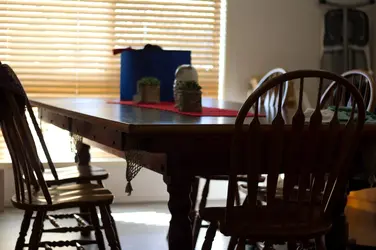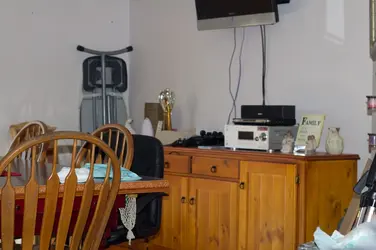In full "auto" mode (the mode dial is set to the green box) the camera will decide when to use the flash. It electronically pops up the flash. If you're in a dark room but you point it at a window then it'll meter the window -- which wont appear to need flash.
If you want to manually control when the flash fires then you need to take it out of full auto mode. "Program" mode (the "P" on the mode dial) is very similar to full auto in that the camera will mostly make all the decisions by default, except you're allowed to override them. In Program mode you can force the flash to fire or not fire. The button on the front of the camera (left side of the lens) has a lightning bolt... that releases the catch that pops up the flash. If you pop-up the flash in "program" mode then it will use it (well... there's also a menu function which can manually enable or disable it but the default is to enable it when the flash is up.) To turn the flash off... just push it down (it's spring-loaded).
You will notice that if you go back to auto mode and press that same lightning bolt that it will ignore you... it wont pop up. In auto mode the camera makes pretty much ALL the decisions (it'll let you decide to use the self-timer... that's it.)
Pick up a copy of the Bryan Peterson's book "Understanding Exposure" - great book for beginners with a camera like yours. David Busch has a series of books for most popular DSLR camera models that explains how to use that specific model camera. Checking Amazon I see they list the book for the T4i except it's a pre-order. The book doesn't release until Oct 2. The title is "David Busch's Canon EOS Rebel T4i/650D Guide to Digital SLR Photography". I've seen his books for other model cameras and they tend to do a much better job explaining how to use things than the owners manual.
Let's test your flash and make sure it works (since this is a new camera there's always the possibility that there's a defect. Although that'd be incredibly rare and the camera is probably fine, we may as well test it while you have time to exchange it.)
Power up the camera. Change the mode dial to the "P". Press the lightning bolt button on the FRONT of the camera (left side of the lens). The flash SHOULD pop up (it wont fire... it'll just release the electronic catch that lets the flash spring up.) If it doesn't pop up, that's a problem. Assuming it did pop up, the flash should fire when you take a shot regardless of the lighting conditions -- including in broad daylight (as long as you didn't go into the menu system and tell it to set the built-in flash to "disable" it will fire - and the factory default is "enable".) Take a shot and make sure it fired. All this needs to be done in the "P" (Program) mode.
Now switch it back to full Auto mode (the green box on the mode dial). Push the flash back down to close it. Take the camera to a dark room. Make sure you are not pointing it near a window, lamp, or anything else that would fool it into thinking it has enough light. The room needn't be black... but if you point the camera at a window in a dark room it's going to expose for the light OUTSIDE that window (where it'll realize it doesn't need a flash because it's daytime.)
Press the shutter button HALF WAY while looking through the viewfinder. The camera may make some noise. You *might* see the word "busy" in the left corner of the viewfinder. Ultimately you should hear the flash pop up, you should hear a single beep (meaning it's locked the exposure settings) and you should see a lightning bolt icon in the lower left corner of the viewfinder (meaning that the camera intends to use the flash.)
Fully press the shutter button. The camera will take the shot and the flash should fire. (It is not possible to use the menu system to override the flash in full auto mode. In other modes, yes. Just not in full auto mode.)
Let us know if you were able to pop up the flash in "P" mode and if the flash fired. If it doesn't, then either someone has gone into the menu system and disabled the flash (and if this is truly a brand new camera and nobody else has been using it that shouldn't be the case) or the flash is defective.
Assuming the flash worked, then let us know if it also works in full "auto" mode.
Part of the beauty of owning such a camera is NOT to use full auto mode anymore. The point of the camera is that rather than having to accept the computer algorithms that go for relatively safe exposures that most cameras use, you can take control -- you decide when a flash is used, what exposure settings are used (often to great artistic results -- that you wouldn't get by leaving it on full auto mode), etc.



![[No title]](/data/xfmg/thumbnail/32/32632-476f3d925401f13cffe1cc2b41945614.jpg?1734162117)
![[No title]](/data/xfmg/thumbnail/35/35965-cac1057a7f2dd8e8aeeefed50ae8c080.jpg?1734167827)






![[No title]](/data/xfmg/thumbnail/32/32702-7344d6e6132276dd7bfc046084fea432.jpg?1734162266)


